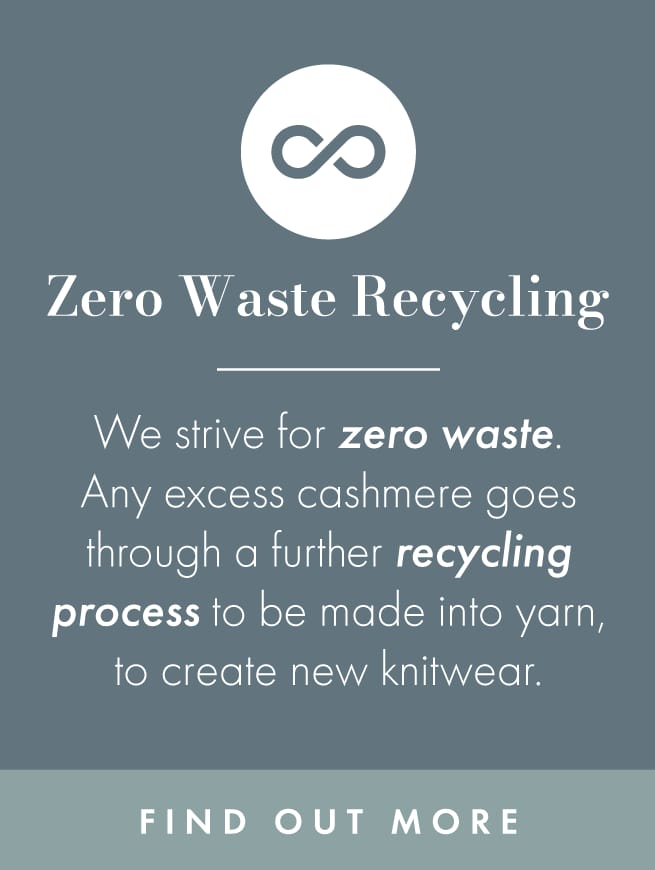What is cashmere?
What is cashmere made of?
Like all wools, cashmere is made using fibres from animal fleece. However, it’s what animal cashmere is from which makes this such a luxury fabric, setting it apart from other wool. Cashmere is made using hair that makes up the exceptionally soft, downy undercoat of cashmere-producing goats. Originating in Kashmir, most cashmere goats can now be found throughout Northern China and Mongolia, as well as Afghanistan, Australia and Turkey.

Why is cashmere so expensive?
The reason why cashmere is so expensive is that the incredibly soft fibres are only found in small quantities around the goat’s neck and underbelly. What’s more, this downy coat only grows during the winter months as the days get shorter.
While the amount varies depending on the breed, one cashmere-producing goat will produce an average of just 150g of cashmere per year. This makes it an extremely rare, and therefore often expensive, fabric.
How is cashmere made?
The first step to making cashmere is to collect the downy undercoat of cashmere-producing goats in spring when they start to moult. While sheep are typically shorn, cashmere fibres are collected by gently combing the goat’s belly and neck. This helps protect the fibres and keep them as long as possible, maximising the yield while also producing a fabric that resists pilling.
The hair is then collected and sorted by hand before sending to a facility to be cleaned, refined and bundled up ready to be spun into yarn. However, with cashmere being such a rare and luxurious fabric, there are growing concerns surrounding both the welfare of these wonderful cashmere-producing goats and the quality of the fibres collected. That’s why we’re working on a connection with a US-based NGO to do our bit and help promote sustainable and ethical cashmere production.
Where does cashmere come from at Turtle Doves?
Dedicated to creating a sustainable future for the cashmere industry, all of our fabrics are sourced from post-consumer cashmere knitwear. Used, enjoyed and then discarded due to shrinking or damage, we recreate this luxury fabric into new garments that can be worn and loved all over again.
When we receive preloved cashmere at our Shrewsbury studio in Shropshire, we gently wash the garment and carefully choose which parts can be recycled into new items. Because of the recycled and sustainable nature of our products, every piece is unique in terms of colour and fluffiness. However, one thing we can guarantee is that every piece is recreated from 100% cashmere knitwear.

What are the unique properties of cashmere?
Cashmere goats produce their soft, downy undercoat to help keep them warm when temperatures plummet to -30°C. This makes it one of the best insulators around, perfect for keeping cosy in the cold winter months! Since it’s a natural fibre, cashmere is also breathable and great at regulating temperatures, making it ideal for milder months, too.
What is cashmere used for?
Cashmere can be used to make a whole range of garments, accessories and even home furnishings. This luxuriously soft fabric is extremely cosy and breathable, making it a popular choice for jumpers, cardigans, scarves and hats.
At Turtle Doves, we’ve also found it to be a great choice for gloves. The insulating properties keep your wrists warm to improve blood flow, helping those who suffer from Raynaud’s and circulatory problems relieve symptoms when temperatures start to drop.
Can you wear cashmere in summer?
Since cashmere is made of natural fibres, it’s extremely adept at regulating our temperatures and is a great choice for summer cardigans, pashminas and other light items of clothing. Cashmere is perfect for taking the chill off during an evening walk or a blustery day at the beach!

Is cashmere itchy?
While it’s true that wool can be itchy, the special fibres used to create cashmere mean it’s soft, gentle and incredibly comfortable against the skin.
The reason why wool is generally itchy is that it comes from sheep. They produce much coarser fibres which can be double or even triple the diameter of those from a cashmere-producing goat. They also produce a waxy substance known as lanolin which covers the wool fibres, and this substance can irritate our skin. Add in the fact that wool is often mixed with non-breathable synthetic fibres, wool has gained a bad reputation as an itchy fabric.
In contrast, goats produce much finer, more flexible fibres than sheep. Plus, since cashmere is sourced from the goat’s underbelly where it needs less protection from the elements, it contains little to no lanolin. All of this means that cashmere is one of the softest, warmest and comfiest fabrics to snuggle up in.
How do you stop cashmere itching?
Pure 100% cashmere is known as one of the softest non-itchy fabrics around. However, some people may find they have an allergy to the natural cashmere fibres or that it irritates their sensitive skin. If that’s the case, then try wearing a cotton base layer underneath to create a protective barrier between the fabric and your skin.
Alternatively, if you’ve purchased a product elsewhere that isn’t pure cashmere or is of low quality, you can try soaking your garment in cold water mixed with two tablespoons of white vinegar. Once saturated, remove from the water and apply a quality conditioner to help soften the goat hair that the cashmere is made from.
Leave the conditioner for up to half an hour before rinsing off thoroughly with cold water. To make sure it keeps its shape, gently press the water out of the garment and lay it flat on top of a towel to dry.
If you purchase cashmere from Turtle Doves, rest assured that we only use 100% quality cashmere for your comfort.
How often should cashmere be washed?
Because our products are made using 100% cashmere, the natural fibres are highly breathable and don’t hold onto odours. This means they need washing less than other fabrics, helping cut down on your laundry. And since cashmere is naturally antibacterial, it’s usually a case of less is more.
When wearing cashmere directly against the skin, generally aim to wash garments every 3–4 wears. If you’re wearing them over base layers, this can be increased to every 5–7 wears. However, if you have a spill, this will need to be washed off as soon as possible.
As for our cashmere gloves, we recommend washing them once they start to look dirty or if wearing them all day, then after several wears. The same rules also apply to our scarves and beanies, and since these are larger items, this will usually be less than the gloves.
At the end of each season before packing away your accessories, all items should be washed carefully. To help make this process easier, we’ve made sure all our cashmere products can be machine washed on a cold setting. Reshape, dry flat and store in airtight bags away from fibre-loving moths!
Shop sustainable cashmere with Turtle Doves
Whether you’re looking for a luxury gift or just want to treat yourself, we have a selection of sustainable cashmere accessories. From our fingerless gloves and adult mittens to cashmere loops and socks, each item is unique and has been lovingly handmade from preloved knitwear.





